Banija Earthquake Damage Estimated at €5bn, Says Jutarnji List
ZAGREB, 13 March 2021 - The direct damage of the devastating earthquakes in the Banija region on 28 and 29 December is estimated at a little over €5 billion, which is about 10% of Croatia's GDP, Jutarnji List daily said on Saturday, citing unofficial figures.
If one adds the direct damage caused by the March earthquake in Zagreb and its environs, the total is about €16.6 billion or HRK 124.5 billion, just a few billion kuna less than one annual state budget or 32% of GDP.
The estimates after both earthquakes were done by World Bank consultants in cooperation with the Construction Ministry and the Regional Development and EU Funds Ministry.
Eventually, the damage caused by the December quakes could rise to €5.5 billion. It covers the three counties affected - Sisak-Moslavina, Karlovac, and Zagreb - but it's clear that most of the damage was caused in towns and villages in Banija.
After the Zagreb earthquake in March 2020, the damage was estimated at €11.6 billion, twice as much as the damage estimated after the December tremors in Banija, which makes sense given that the areas affected in Banija are mostly rural, with people living in houses. In Zagreb, tenements were damaged too.
The damage was calculated also by density of locality and type of building as well as property prices, which are much higher in the centre of Zagreb than in Glina, Petrinja or Sisak.
According to the latest information, 37,512 buildings have been reported as damaged in Banija and 31,550 have been inspected, with 4,009 receiving a red label, meaning they are unusable, and 6,918 receiving a yellow label, meaning they are temporarily unusable.
In Zagreb, 38,600 buildings have been inspected, with 4,436 receiving the red and 8,318 the yellow label.
Croatia applied for money from the EU Solidarity after the Zagreb earthquake and an application is being prepared for Banija. The deadline for applying is 23 March, but the government will do so by the end of next week, Jutarnji List said.
For more information about earthquakes in Croatia, follow TCN's dedicated page.
As Many People have Moved to Banija as have Left after Quake, Jutarnji List Says
ZAGREB, 11 March 2021 - As many people have moved to the Banija region as have left after the magnitude 6.2 earthquake of 29 December, Jutarnji List daily said on Thursday, wondering if those who have moved there are after the post-earthquake reconstruction money.
Many people have left all over Sisak-Moslavina County after the devastating earthquake and the constant aftershocks are making those who have stayed think about leaving.
However, few would have imagined that the number of those who have moved out of the county, changing their place of residence, would be almost the same as the number of those who have moved to Sisak-Moslavina County since the earthquake, registering as residents.
According to county police data, 171,066 people were registered as residents as of 31 December and 170,761 as of 9 March.
Between 1 January and 9 March, 208 people moved from Sisak-Moslavina County to another county in Croatia and 22 moved abroad, 176 people moved to that county from another county in Croatia and 13 from abroad, and 803 people changed their residence within the county, Sisak police told Jutarnji List.
The actual number of those who have moved out of Sisak-Moslavina County and those who have registered their residence in another county in Croatia is ten times higher, but the almost equal number of those who have officially moved out or to the county is evident, the newspaper said.
eReconstruction System Begins Operations in Post-Earthquake Petrinja
March the 6th, 2021 - The eReconstruction system is now in operation in earthquake-stricken Sisak-Moslavina County in central Croatia, aiming to make administrative processes for those who need construction services more easily accessible.
As Poslovni Dnevnik/Marija Crnjak writes, Minister of Construction Darko Horvat recently presented a new system for the electronic submission of requests for the reconstruction of earthquake-damaged buildings - the innovative new eReconstruction system. Croatia´s eReconstruction system has otherwise been in operation for a couple of days now, and the minister has emphasised the fact that it will speed up the process of submitting and receiving applications.
"In cooperation with the company APIS IT, we created the eReconstruction system in order to make the process of applying for renovation/reconstruction following the earthquake as easy as possible for our affected residents and to offer them several different opportunities for this purpose," explained Horvat.
Easy access to the application for all natural and legal persons is provided through the e-Citizens (e-Gradjani) system, and a level three credential will be sufficient for entry via NIAS.
The Minister revealed that the doors of the Reconstruction Information Centre will also open in the centre of Zagreb by March the 15th, which will house officials of the Ministry, the Reconstruction Fund and the Central State Office for Reconstruction and Housing, as well as employees of the Legal Clinic.
People will be able to get their hands on all of the necessary information and advice there, and they will also be able to submit requests for property reconstruction.
"We want to continue to be here, present on the ground as much as possible, so that we can make the procedures for submitting applications for reconstruction as simple as possible. Our focus now is on issuing the first decisions on reconstruction, so that they are sent to the Fund and the Central State Office for operationalisation and the beginning of the organisation of reconstruction, " concluded Minister Darko Horvat.
For more on the Petrinja earthquake, follow our dedicated section.
PHOTOS: Prefab Housing Project for Earthquake-Damaged Homes in Banija
February 28, 2021 - A housing project to replace the severely earthquake-damaged homes in Banija, made by experts from the Faculty of Architecture in Zagreb, has been completed.
Jutarnji List reports that about twenty types and sixty subtypes of typical modular prefabricated houses are ready for execution in the earthquake-affected area.
Namely, the Ministry of Physical Planning, Construction, and State Property is preparing a tender for contractors to replace the houses in Sisak-Moslavina and Karlovac counties. Several companies that produce typical houses or elements have shown interest in this venture at an enviable technological level. With the desire to improve such products in terms of space and design and comply with demanding regulations, teachers of the Faculty of Architecture in a short time designed a series of projects of typical modular prefabricated houses that have been merged into an ambitious publication, “Post-earthquake reconstruction for typical houses,” which should be printed in early March.

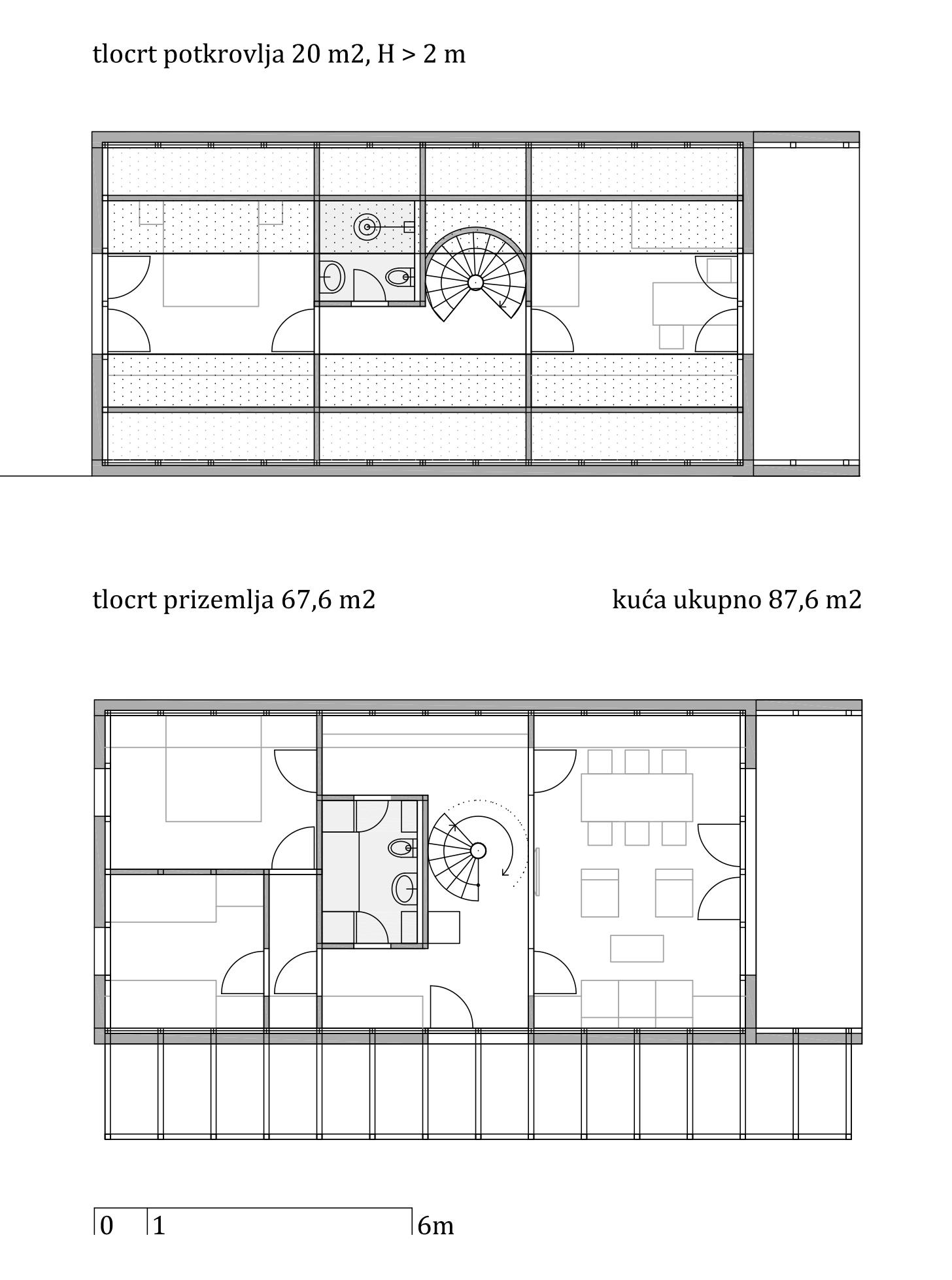
Mladen Josic, Minja Josic
Typical modular house with the possibility of expanding into the attic space (spatial view and floor plans)
Prof. Mladen Jošić is one of the leading designers of (multi) housing construction in the Republic of Croatia and the author of norms (dimensional standards) that should be used to design standard solutions for Banija. The project includes the possibility of expanding into the attic and optional additional elements (front and side porch)
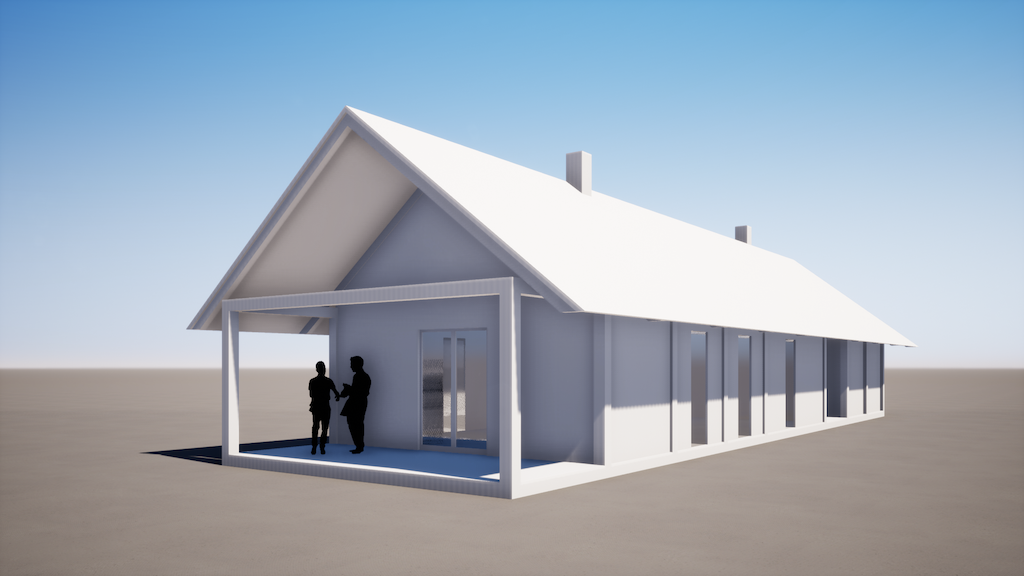

Vedran Duplančić
A typical modular house is based on a container module - spatial view and floor plan + facades.
Vedran Duplančić is a professor at the Department of Architectural Structures and Building Physics. His project - which is created in the module of one type of container - seeks to implement economic facilities under one roof, in addition to housing: tool storage, tractor parking, etc.
Since the fatal earthquake on December 29, 2020, which hit the area of Sisak-Moslavina County and a series of subsequent shakes that are still ongoing, the Zagreb Faculty of Architecture has been active in structured involvement to help the hardest-hit areas.
"Aware of the lack of time and speed with which to solve problems in the field, we decided to propose the production of different types of family houses with a special focus on light, semi-prefabricated and prefabricated houses made of lightweight materials. At the same time, in all types of houses, the proposed light construction can be replaced by classic and monolithic brick and concrete construction, without changing the floor plan and design," said dean Bojan Baletić.
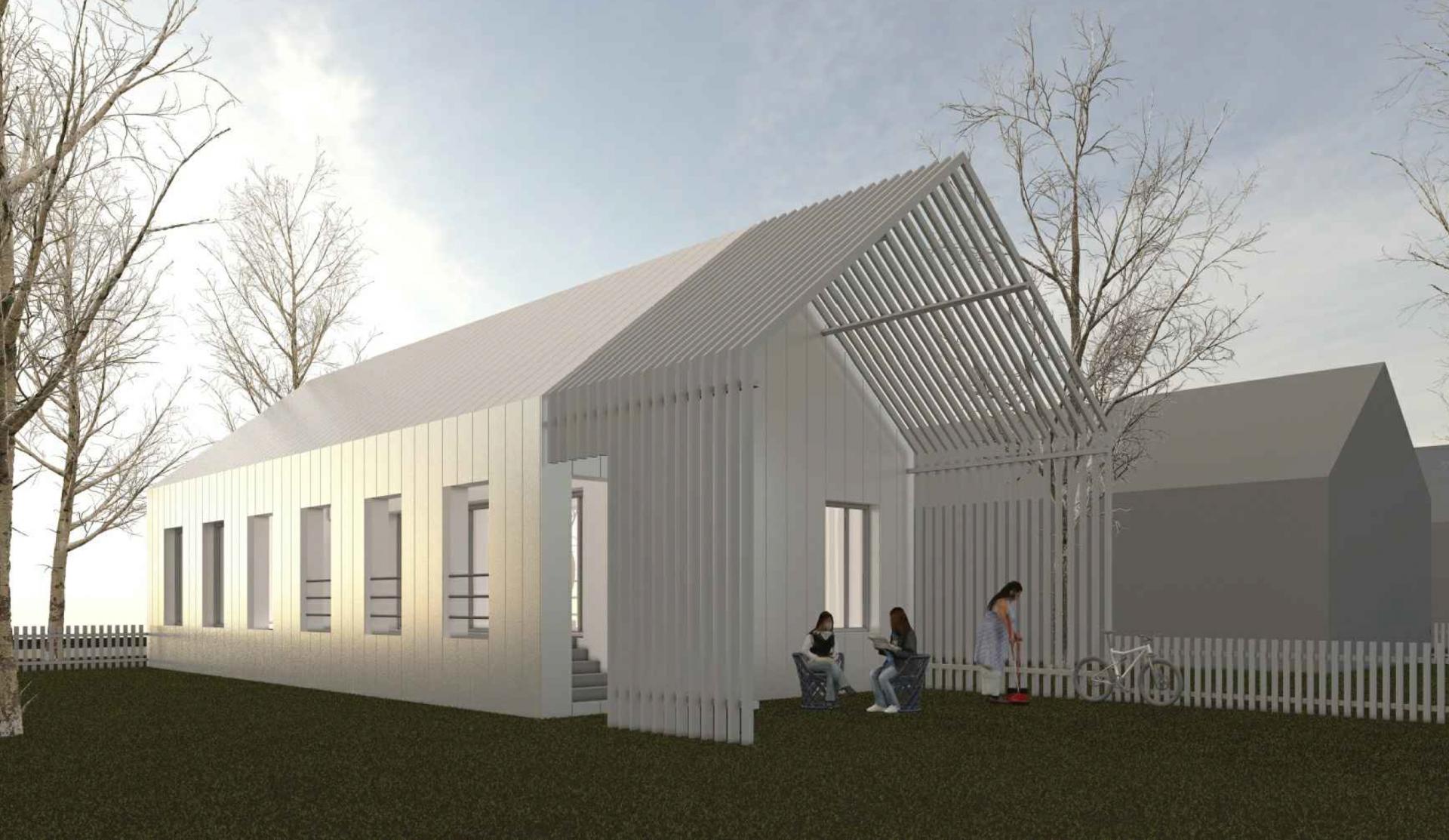
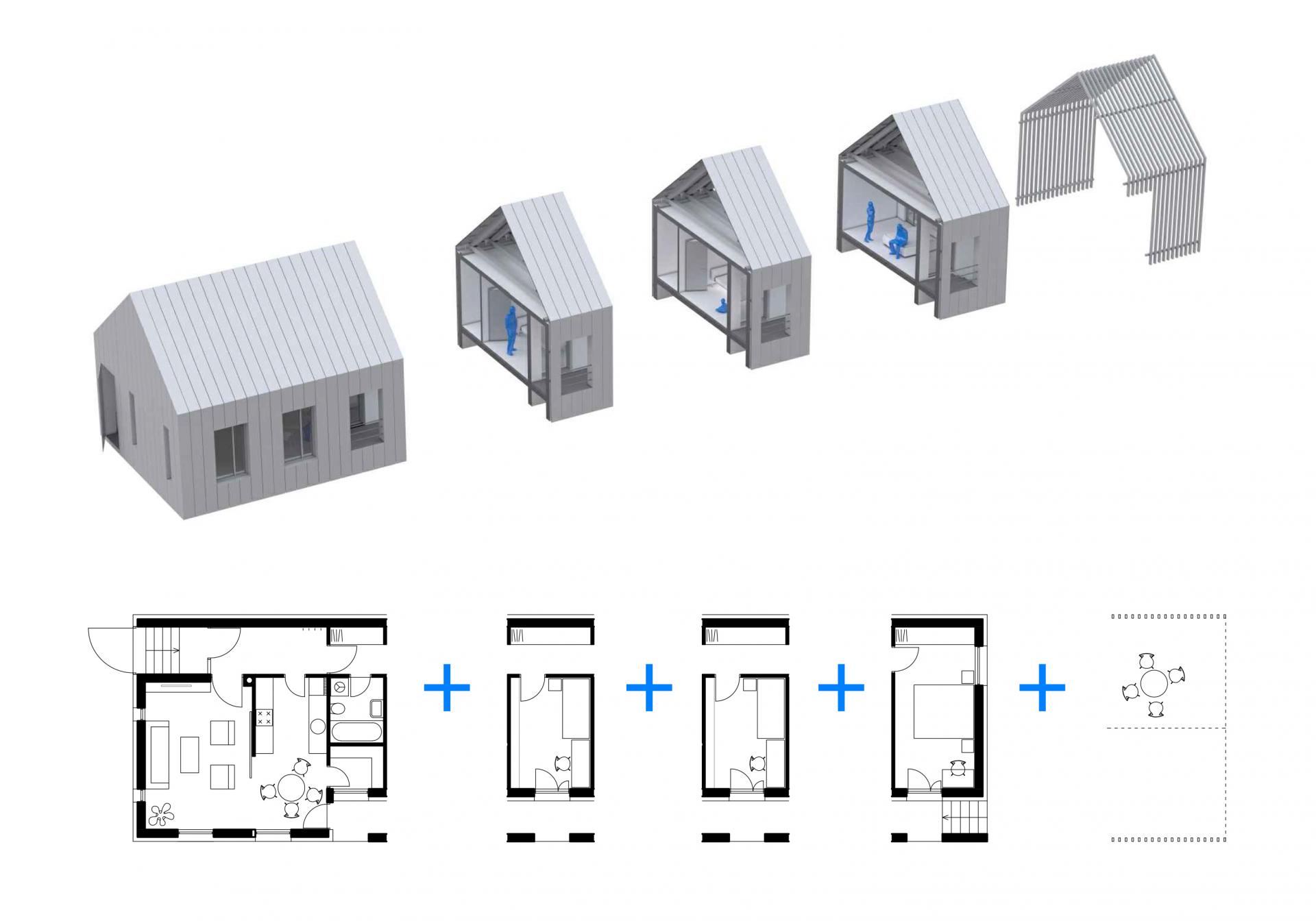
Luka Korlaet, Nino Virag
Typical modular house with a barn - simulation and scheme of modular growth
Luka Korlaet and Nino Virag are teachers of the Cabinet for Residential Buildings of the Department of Architectural Design, where they continuously study new types of housing organizations. This house connects with the environment, i.e., the plot's economic part.
The characteristics of the resulting examples, he adds, are evident in the modular design and construction, the variability of the dynamic floor plan, and the recognizability of the volume.
"All offered types of houses are designed for workshop-factory production in parts and assembly on construction sites. All projects use wooden, metal, or combined construction. They can be performed on light foundations - piles or foundation slabs. They meet the requirements of the nZEB in a rational and practically enforceable manner. They use renewable energy sources. They represent dry and fast construction," Baletić points out.
About twenty teachers were engaged in the development of project solutions. All the proposed houses consider the features of traditional architecture, but not in the banal sense of repetition of form, but in terms of creative interpretation of the local way of life. The teachers/designers were very well acquainted with the history of architecture of this area because they were described by experts Aleksandar Freudenreich, Davor Salopek, and Jasenka Kranjčević.
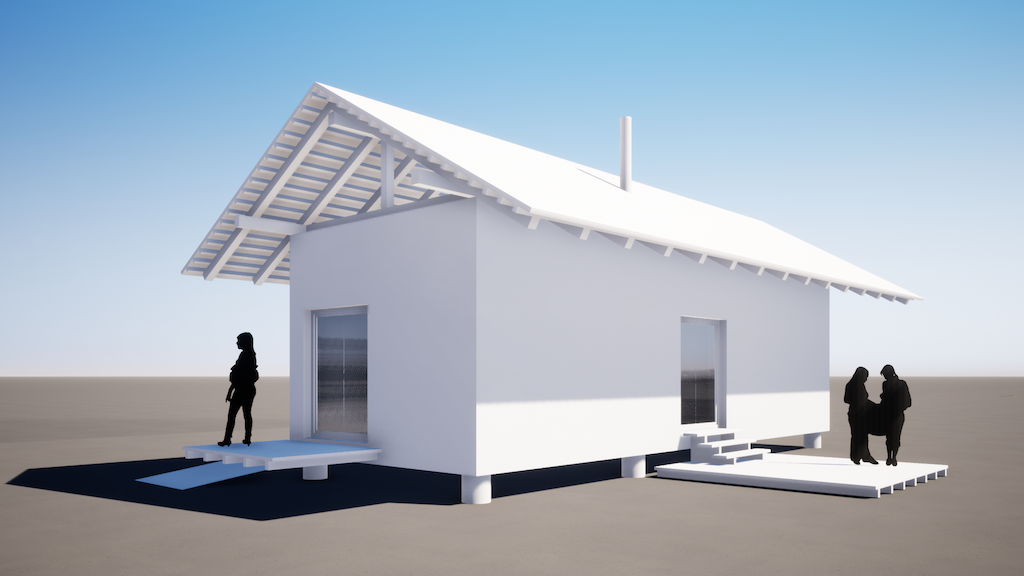
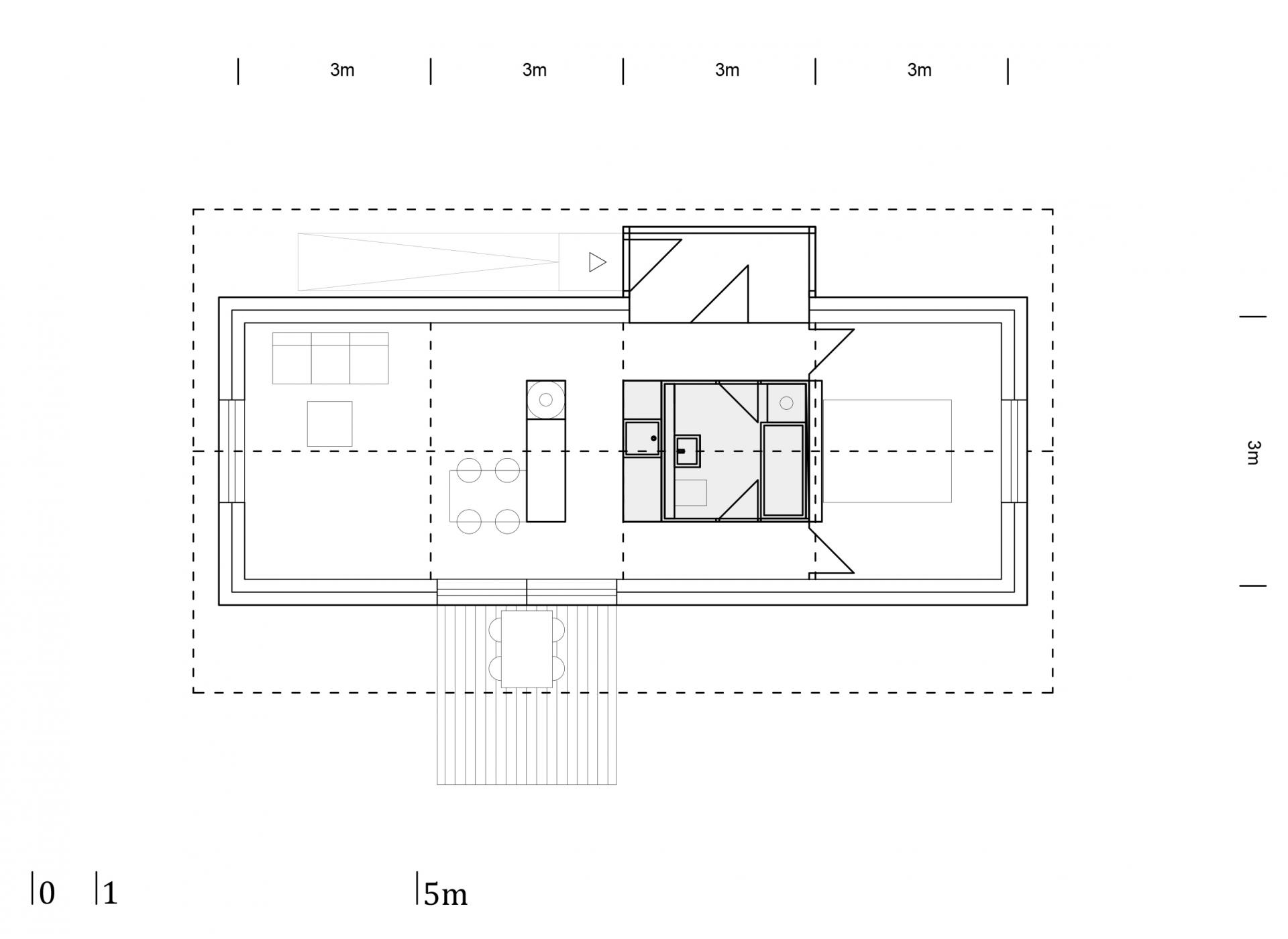
Lea Pelivan + Studio UP
Typical modular prefabricated house of 50 m2 - view and floor plan
Lea Pelivan is a professor in the Cabinet for Residential Buildings of the Department of Architectural Design and a partner in the project bureau Studio UP. In practice and teaching, she works in typological research, i.e., finding answers to the question of how architecture should / could respond to the spirit of the times.
The publication aims to position the profession (architects) in the place it deserves, i.e., to point out the necessity of quality and functional organization of space and adequate design. Furthermore, the intention is for architects to recognize themselves as unavoidable participants in the reconstruction. It is impossible to imagine or carry out the reconstruction of earthquake-devastated spaces. The criteria for selecting designers and contractors and the allocation of replacement facilities have yet to be determined by the competent Ministry. In this process, the Faculty of Architecture and the Croatian Chamber of Architects are partners and advisors in design and construction.
"The Faculty intends to conclude cooperation agreements with potential contractors. We have already established contact with several companies, and their representatives realize that they would be more competitive with better architectural solutions," says assistant professor Luka Korlaet, executive editor of the publication. Public procurement for the construction of typical replacement houses will be evaluated according to the price, deadlines, and, they hope, the proposed architectural solutions' quality.
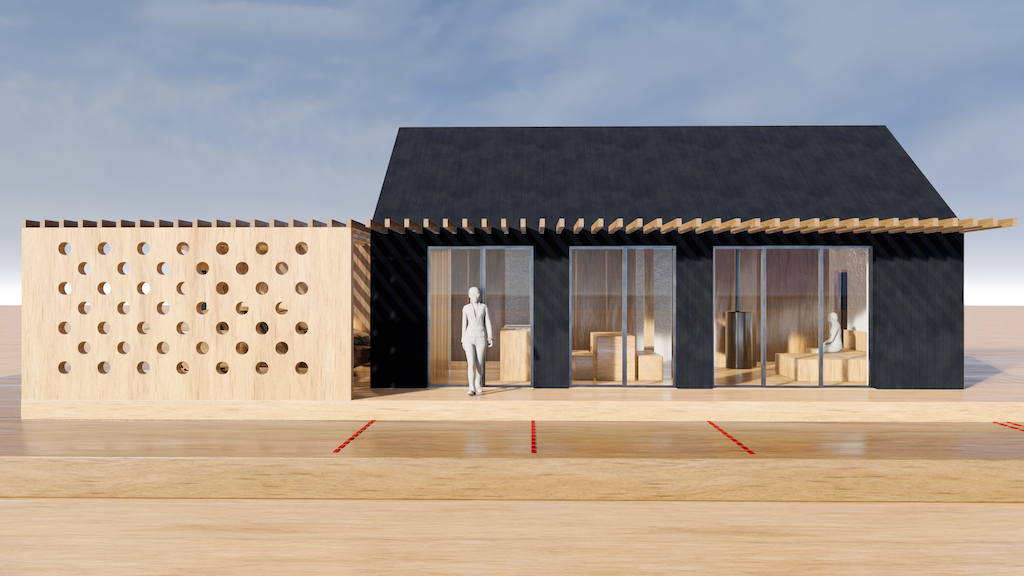
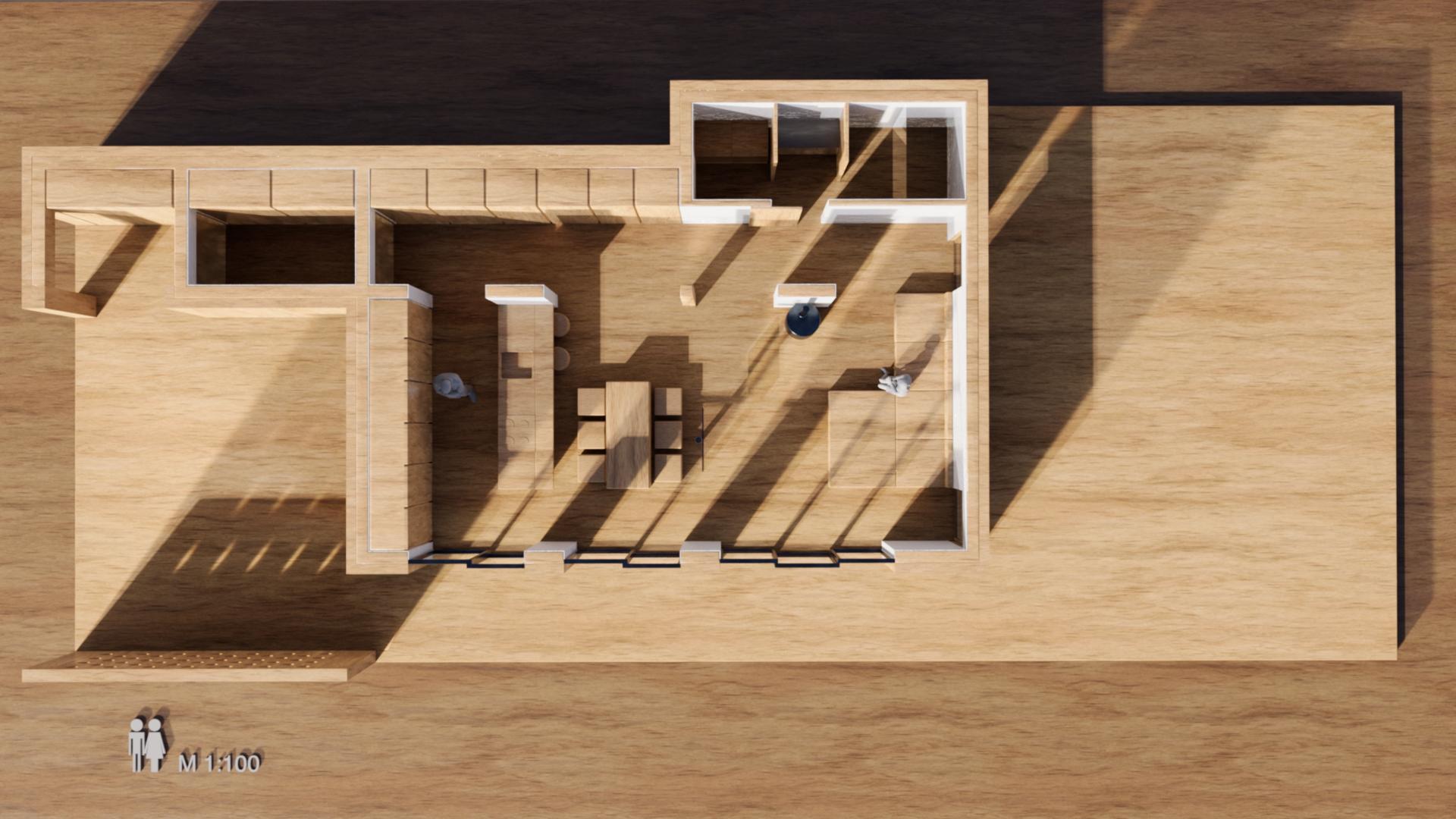
Alenka Delić
Typical modular house - exterior view and floor plan/layout
Alenka Delić is a professor at the Cabinet for Residential Buildings of the Department of Architectural Design, where she continuously works with typical, modular houses. The project in the picture is created in collaboration with a contractor and is a great example of synergy.
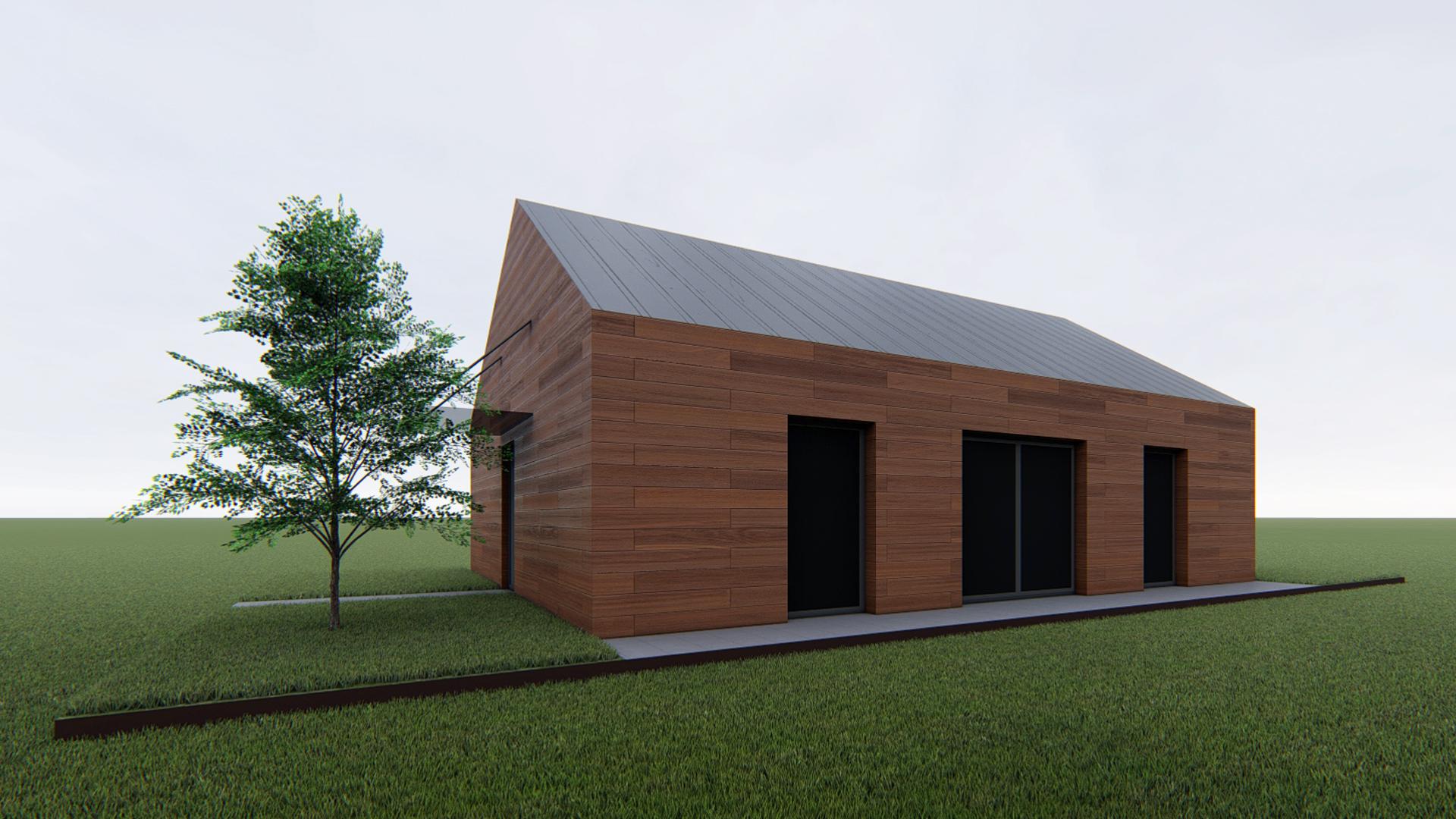
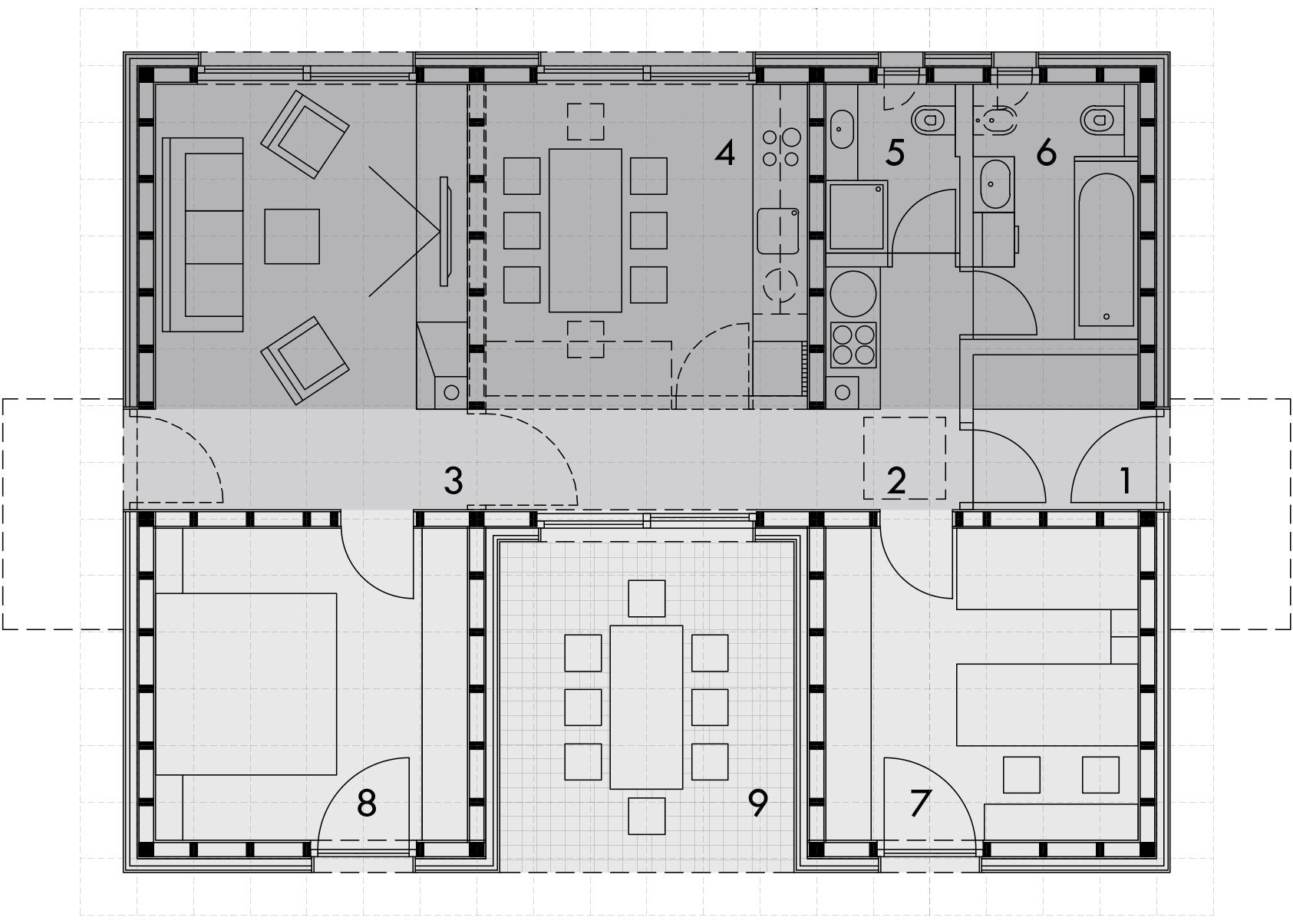
Ljubomir Miscevic, Mark Miscevic
Typical modular house in PGS system - simulation and floor plan
Prof. Ljubomir Miščević is the doyen of prefabricated modular construction in the Republic of Croatia, who patented several systems and products (PGS, EcoSandwich, among others). He has chaired the Passive House Croatia Consortium for years. He developed this system in collaboration with his son Mark, also an architect.
"Our faculty staff is an attempt to control the quality of the future built space as much as we can," Korlaet points out. We also discuss several proposed projects and variations. The range of solutions of about twenty of them guarantees that the reconstruction will not be uniform: there are 3500 severely damaged houses, and it would not be good to replace them all with two or three types/subtypes.
The companies that will compete have different technological starting points and will choose the types that suit them. The Faculty of Architecture solutions are similar but again different and creatively interpret local housing models. A special category of renovation consists of outbuildings, which should be in focus because all the residents of Banija emphasize the importance of accompanying economic activities, i.e., care for poultry and livestock.
"The entire public, and especially us as experts, were disturbed by images not only of demolished old brick houses, mostly from the 19th century, but also scenes of several relatively new buildings that collapsed. This indicates improvised or illegal construction, as well as the bad consequences of the legalization of inadequately built facilities," says Professor Karin Šerman.


Krunoslav Šmit, Nataša Ivanišević, Katarina Kozlović, Ivan Matorić
Simultaneously, there were numerous donations of building materials, which alerted the architects. With respect for the good intentions and necessity of such noble gestures, there could be further uncontrolled and unprofessional repairs and construction, and thus possible further dangers.
"Due to all these perceived threats, as well as the general scope of tasks, we decided to get involved as an institution in various areas and levels of our activities - from professional to educational."
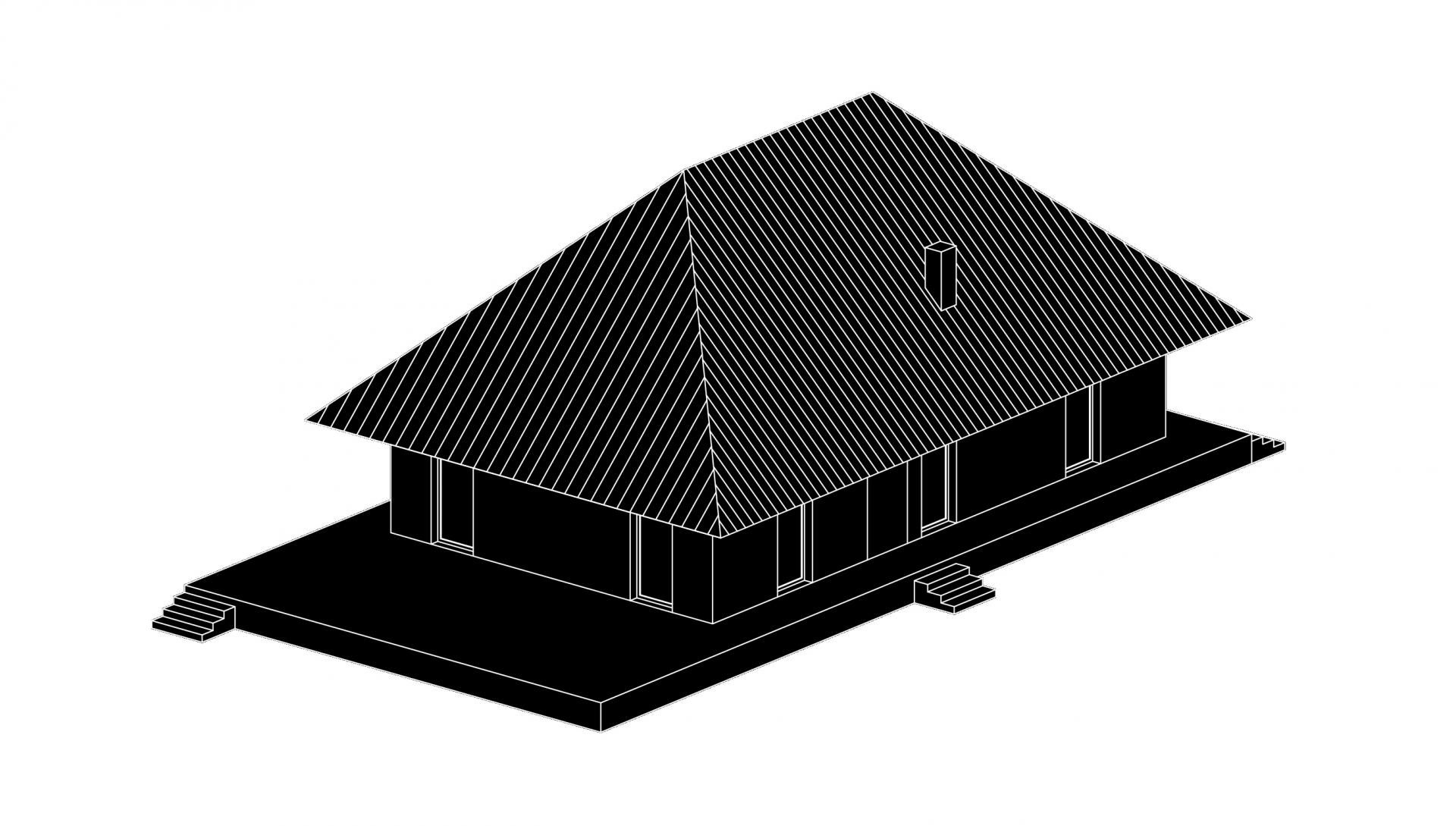

Ivana Ergic, Tamara Relic, Jana Horvat
Typical prefabricated house with a habitable roof - spatial view and floor plan
Ivana Ergić is a professor in the Cabinet for Residential Buildings of the Department of Architectural Design and young teachers, doctoral students Tamara Relić and Jana Horvat. Their solution - by interpreting the traditional pitched roof - leaves the possibility of expanding into it.

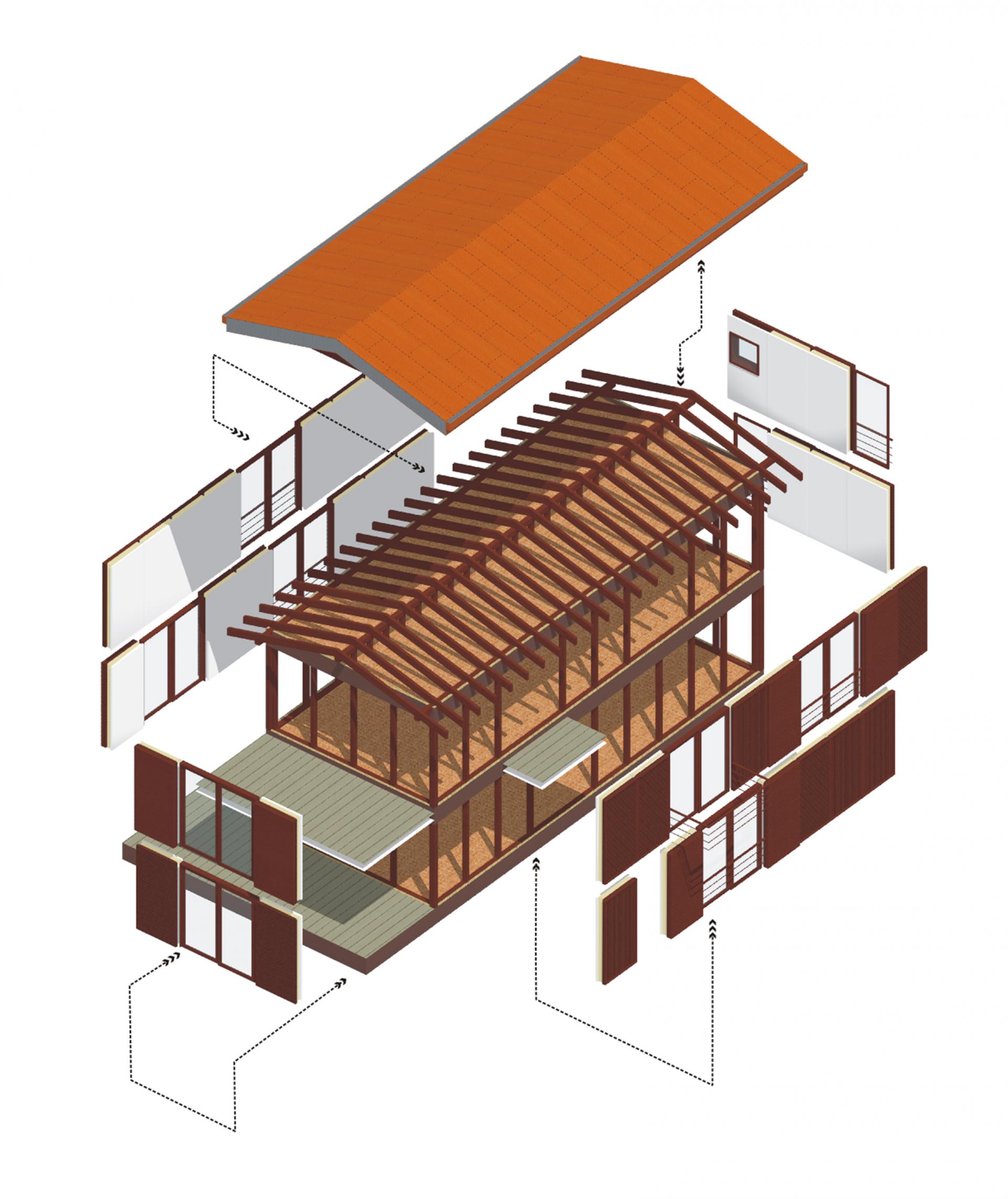
Ivica Plavec
Project of a typical modular house from the Klik-dom system - simulation and analytical presentation of building elements
Ivica Plavec is a professor at the Department of Architectural Structures and Building Physics. In his rich career, he especially dealt with modular construction in wood and developed a system called Klik-dom. In this system, he designed several houses that can be modularly increased in width and height.
"Through these projects of new, replacement buildings and houses and their backyards and farms, the tasks of organizing the space of damaged villages, restoration of collapsed urban tissues of historic cities, reconstruction of individual cultural monuments and valuable architectural heritage, and the necessary care to preserve the overall spatial and urban identity recognizable spatial and architectural spirit, we find responsibilities for our architectural and urban planning profession," concludes Šerman.
To read more about the Petrinja earthquake, follow TCN's dedicated page.
Sisak-Moslavina Earthquake: Unsafe Stickers "Decorate" More Than 10,000 Buildings
February the 26th, 2021 - Following the devastating Sisak-Moslavina earthquake which caused ruination and even the loss of life in central Croatia at the very end of what was truly a terrible 2020, yellow and red ''unsafe'' stickers now decorate more than 10,000 ruined buildings within the area.
As Vecernji list/Danijel Prerad writes, according to this morning's updated ArcGIS data, serious damage caused by the Sisak-Moslavina earthquake back in December last year was reported on 37,679 buildings, of which 29,262 were inspected by staticians. Due to that damage, 3,456 buildings were given a red sticker, and due to external influences, another 346 objects can now be removed.
2,913 facilities remain temporarily unusable until a more thorough inspection can take place, and urgent interventions are needed for an additional 3,493 buildings that also cannot be used for now.
Only 644 of the inspected buildings remain without damage, and the more than 18,400 buildings have received a green ''safe for use'' sticker, a statement from Sisak-Moslavina County read.
As of today, the office of the Ministry of Physical Planning, Construction and State Property has been opened in earthquake-stricken Sisak at the following address: Ivana Kukuljevica Sakcinskog 1 (the Fina building).
At the aforementioned location, Sisak residents can now submit their requests for property reconstruction and renovation. On Friday and Saturday this week, mobile offices will be present in the settlements of Majur and Grabostani. On those days, mobile office employees will receive requests for the restoration of the damaged facilities in Majur for the area of Majur, Stublje and Gornji Hrastovac, and in Grabostani for the area of Grabostani, Veliki and Mali Krcevo, Svinica, Mala Srednje and Gornje Meminske and Mracaja.
Officers will receive requests and help locals fill out any of the forms and resolve other issues of an administrative nature. Citizens will only be able to initiate the renewal procedure with a system that is directly connected to the cadastre, land register and other official databases by presenting an identity card and filling out a simple form. Requests for the reconstruction of buildings in the area following the Sisak-Moslavina earthquake must be filled in before anything can occur and the most basic information of the applicant will be required.
For the latest travel info, bookmark our main travel info article, which is updated daily.
Read the Croatian Travel Update in your language - now available in 24 languages.
Government to Give 40% of 100 Million HRK Donation for Petrinja Home Restoration
February the 25th, 2021 - Petrinja home restoration efforts, which are unfortunately happening only very slowly, might have had another blow in the financial form as a huge donation is scrutinised.
As Jutarnji list/Goran Penic writes, enormous funds of more than 100 million kuna in total were paid out to the state treasury in an initiative called "Assistance for reconstruction after the earthquake" by numerous citizens and companies from across Croatia and indeed from abroad, as well as international organisations and foreign governments. As has unfortunately since been found out, it seems that it is likely that only a small part of that massive amount will be spent on Petrinja home restoration efforts, and the remaining 60 percent of the money should apparently be allocated to some other ''earthquake-related'' purposes.
Jutarnji list is in possession of a proposal for a decision prepared for the Croatian Government by the Ministry of Finance, which defines how the money collected through donations will be distributed. According to the proposal, 40 percent of the money, or about 40 million kuna, would go to the Central State Office for Reconstruction and Housing, for the removal of now destroyed family houses and for the construction of their replacements.
Up to 20 percent of the donated money, equal to about 20 million kuna, would go to the account of the Ministry of the Interior (MUP) to cover the payment of the costs of individuals and legal entities which were mobilised by order of the National Civil Protection Directorate/Headquarters.
These include companies that set up tents, for example, as well as the transport companies that transported mobile homes, construction companies that worked on repairing chimneys and roofs or for hired cranes. On top of that, the state-owned company Pleter will more than likely be in for a cut. Pleter was engaged in preparing food for the victims in the immediate aftermath of the earthquake after it had been being done for days anyway by good-hearted volunteers, as well the owners and employees of famous Croatian restaurants who had already faced huge financial issues due to having to be closed during the pandemic.
Citizens and companies, in addition to money intended for Petrinja home restoration and the covering of the costs of mobiliaation, seem to have donated money for commodity stocks without even being aware of it. As such, 10 million kuna, or up to 10 percent of the donated money, should be paid to the Ministry of the Economy, more precisely to the Directorate for Commodity Stocks to cover the costs of purchasing goods in accordance with the decisions of the National Civil Protection Headquarters.
It should be recalled that it was the Commodity Stocks that were most criticised following the earthquake in central Croatia back in December 2020 for delays in the delivery of aid, as living containers and tents ended up arriving from some of the most remote places in Europe rather than from commodity reserves.
The Ministry of Labour should not be left without any money either. They could allegedly get their hands on as much as 15 million kuna for the reconstruction of buildings that were damaged in the earthquake. Specifically, up to 15 percent of the donated funds would be spent on the construction/reconstruction and equipping of institutions operating within the social welfare system. Institutions in the social welfare system are social welfare centres, homes for the elderly and infirm, homes for children, Caritas, the Red Cross, foster families and the like.
According to reports, three buildings operating within the social welfare system were completely destroyed in the earthquake, and two are temporarily unusable, including homes for the elderly and infirm in Petrinja and Sisak. According to this decision, the Ministry of Agriculture should receive 15 percent of the funds, ie 15 million kuna for support to agricultural producers, which includes measures for preventive vaccination and the treatment of animals in the area.
Jutarnji list asked the Ministry of Finance to clarify this decision, but they didn't answer their specific inquiry, but simply said that the Croatian Government would soon make a decision on the redistribution of funds.
"The Croatian Government opened an official account of the State Treasury for donations of funds in the action ''Assistance for reconstruction after the earthquake''. By the 22nd of February 2021, 100.1 million kuna had been paid into this account (this is preliminary data). These funds will be used according to the decision of the Government, which should be made soon. To date, payments have been made from the state budget, ie redistributions within the users of the state budget,'' the Ministry of Finance said in its response to Jutarnji's query.
The Government claims that this was one of the proposals, that more than 100 million kuna was collected, but that the distribution model, which is being presented to the Government today, will still be different in the end.
For more on Petrinja home restoration, donations and the Petrinja earthquake in general, follow our dedicated section.
763 Applications for Reconstruction of Quake-Damaged Buildings Submitted So Far
ZAGREB, 24 February 2021 - The Construction Ministry has so far received 763 applications for the reconstruction of buildings damaged in the March 2020 earthquake while the Fund for the Post-Earthquake Reconstruction of the City of Zagreb, Krapina-Zagorje and Zagreb counties has not received any.
"The ministry received 763 applications by yesterday. The Fund has not received even one," the Fund's director, Damir Vanđelić, said in Donja Stubica, about 50 kilometres northwest of Zagreb, adding that the fund was paying out allowances for urgent repairs, with 242 such payments having been made so far, and that it was in charge of emergency accommodation.
Asked whether the Ministry of Physical Planning, Construction and State Assets was perhaps boycotting him, Vanđelić said that "so far no one has been boycotting me."
"I believe that the process will start at a particular moment because I have seen those people in Banovina, too, helping citizens fill out application forms. They will start forwarding the applications at a particular moment," he said and reiterated that he did not believe the ministry was boycotting him in any way.
Vanđelić met in Donja Stubica with Krapina-Zagorje County Prefect Željko Kolar and his associates as well as other local officials to discuss activities related to reconstruction in that county.
Speaking about the start of reconstruction works, Vanđelić underscored that he first needs to be issued with a decision to that effect by the ministry, after which he will be able to say when reconstruction will begin.
He noted that he would be heading the Fund for some time and that when reconstruction was launched and gained momentum, he would asked to be relieved of his duties.
"I definitely will not serve the full term because I will do my best for reconstruction to be launched sooner. If we fail to make it sufficiently fast, I will resign," said Vanđelić, appointed on Tuesday for a term of four years.
Kolar said that the damage in Krapina-Zagorje County from last year's two earthquakes, with the second happening on 29 December and hitting Sisak-Moslavina County worst, had so far been estimated at HRK 115 million.
During the meeting it was said that structural engineers would inspect buildings that were initially labelled green but have been damaged since and will most likely now be issued with yellow labels.
It was also noted that some families could not claim damages because their houses were built without a building permit.
Damir Vanđelić Confirmed as Post-Earthquake Reconstruction Fund Director
ZAGREB, 23 February 2021 - The Steering Council of the Post-Earthquake Reconstruction Fund on Tuesday unanimously confirmed Damir Vanđelić, until now the Fund's temporary director, as the Fund's director, Physical Planning, Construction and State Assets Minister Darko Horvat said after a session of the Council.
After applications for the post were invited, three candidates applied and the Ministry of Physical Planning, Construction and State Assets proposed Vanđelić at today's session of the Fund's Steering Council and the Council accepted the proposal.
Horvat said that Vanđelić was proposed after all three candidates' applications were analysed and they were interviewed.
Asked if the ministry had asked Vanđelić to guarantee that he would not run for Zagreb Mayor after he refused to be the ruling HDZ party's candidate for the post and after speculation appeared that he would run as an independent candidate, Horvat said that no guarantees were mentioned and that he and the Fund's Steering Council concluded that the Fund's head could not do two demanding jobs at the same time.
"We gave Vanđelić the possibility to choose what he wants to do, he made his position clear and confirmed that he would not run in the coming local elections and that he would use all of his energy and competence to organise the Fund and launch the reconstruction process. We believe him and hence the decision of the Steering Council," said Horvat.
Vanđelić: I will not run in local elections
Speaking to reporters, Vanđelić said that the purpose of the decision to choose him as the head of the Reconstruction Fund was the continuation of what had been done so far regarding the reconstruction process.
"I believe the earthquake is really the most important topic in the country, the most demanding and financially the most important. I therefore believe that the most important thing is to launch the reconstruction process and make sure it is efficient and transparent," he said, dismissing speculation that he would run in the local elections in May as an independent candidate for Zagreb Mayor.
He recalled that he had earlier considered running for mayor, primarily as the HDZ's candidate, and possibly as a candidate of some other parties that would back him but that he abandoned such plans in early February.
"I believe that being the head of the Fund is a more difficult and more responsible task and I believe that I am a better candidate for this job," he said.
Croatia and Slovenia Football Legends to Play Humanitarian Match in Petrinja
February 23, 2021 - Croatia and Slovenia football legends will play a humanitarian match in Petrinja next month, during which UEFA will hand over a donation to the Croatian Red Cross to help the earthquake-damaged areas.
Immediately after the earthquake rocked the Petrinja area on December 29, 2020, UEFA President Aleksander Čeferin spoke with HNS President and UEFA Executive Board member Davor Šuker about ways to help the earthquake-affected areas, reports HNS.
At their initiative, a humanitarian match between Croatia and Slovenia football legends will be played in Petrinja on March 13, during which the umbrella European football federation will hand over a donation to the Croatian Red Cross to help areas affected by the devastating earthquake.
"Our thoughts are with the people of Croatia in these difficult times. We hope that the help of the football family will help them overcome the challenges caused by this devastating earthquake and that it will contribute to the recovery of the Petrinja region," said UEFA President Alexander Ceferin.
On the same occasion, the Croatian Football Federation will hand over a donation to the Sisak-Moslavina County Football Federation, intended to reconstruct the football infrastructure in the earthquake-affected areas.
The co-organizer of the humanitarian match will be the Slovenian Football Federation (NZS), led by President Radenko Mijatović, who will also join the action with a donation.
"We are once again witnessing great solidarity and friendship within the European football family. I believe that UEFA's help will reach the right addresses through the Red Cross and that our help to the county federation will facilitate the return of football in the county.
I am convinced that football is one of the best ways to bring smiles back to people's faces, especially children, so let this game be a sign of a return to normal life," said HNS President Davor Šuker.
The friendly match between Croatia and Slovenia football legends will be played on March 13, starting at 13:00 at the Mladost Stadium in Petrinja.
To read more about sport in Croatia, follow TCN's dedicated page.
Horvat Says will Recommend Vanđelić for Post-Earthquake Reconstruction Fund Director
ZAGREB, 22 February, 2021 - Construction Minister Darko Horvat said on Monday that he would recommend to the post-earthquake reconstruction fund's steering council, which he chairs, to appoint the fund's temporary director Damir Vanđelić as director.
Speaking in an interview with N1 television, Horvat said the name of the fund's new director would be made public tomorrow afternoon.
He confirmed that the call for applications for the position would not be annulled. "Points were given based on public criteria. If we make such a decision at the steering council session, the fund will have its director, and that will be Mr Vanđelić."
Horvat said he was confident they selected and recommended the best candidate to the steering council.
On 29 November, the government-appointed Vanđelić temporary director of the post-earthquake reconstruction fund, for a maximum period of one year, until the appointment of the director. At the end of December, the fund's steering council advertised a call for applications and three candidates applied, including Vanđelić.
For the latest news on the aftermath of the Petrinja earthquake, visit the dedicated TCN section.


